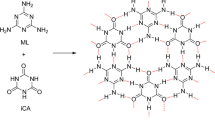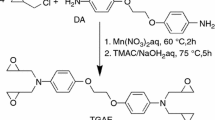Abstract
This paper describes the synthesis of novolac epoxy resin modified polyurethane acrylates (EPUAs) for generating a grafted polymer network, which is different from the conventional interpenetrating polymer networks (IPN). It starts with preparing epoxy acrylate resins (EA) by the ring-opening reaction of novolac epoxy resin (EP) and acrylic acid (AA). Epoxy acrylate copolymers (EPAcs) with hydroxyl groups were prepared by the copolymerization of EA and acrylic monomers. EPUAs were obtained by reacting EPAcs with curing agents (polyisocycanate HDI-trimer and phthalic anhydride). The chemical structures of the obtained EA and EPAcs were characterized by Fourier-transform infrared spectroscopy (FTIR) and 1H nuclear magnetic resonance spectra (1H NMR). The influence of EP on chemical and physical properties of EPUAs, including fracture surface morphology, thermal stability, tensile strength, elongation at break, glass transition temperature (Tg), cross-linking density, shore hardness, water absorption, adhesion, etc., were investigated as well. It is demonstrated that the incorporation of EP into EPUAs greatly enhances the above physico-chemical properties of EPUAs.












Similar content being viewed by others
Abbreviations
- AA:
-
Acrylic acid
- AIBN:
-
Azo-bis-isobutryonitrile
- BA:
-
Butyl acrylate
- DMF:
-
N,N-dimethylformamide
- EA:
-
Epoxy acrylate resins
- EP:
-
Novolac epoxy resin
- EPAc:
-
Epoxy acrylate copolymers
- EPUAs:
-
Novolac epoxy resin modified polyurethane acrylates
- FTIR:
-
Fourier-transform infrared spectroscopy
- GPC:
-
Gel permeation chromatography
- HEMA:
-
2-hydroxyethyl methacrylate
- H NMR:
-
1H nuclear magnetic resonance spectra
- IPN:
-
Interpenetrating polymer networks
- MWD:
-
Molecular weight distribution
- PA:
-
Phthalic anhydride
- PUAs:
-
Polyurethanes acylates
- PS:
-
Polystyrene
- SIN:
-
Simultaneous interpenetrating polymer networks
- ST:
-
Styrene
- TMAB:
-
Tetramethylammonium bromide
- THF:
-
Tetrahydrofuran
- Tg :
-
Glass transition temperature
References
Chattopadhyay DK, Raju KVSN (2007) Structural engineering of polyurethane coatings for high performance applications. Prog Polym Sci 32(3):352–418
Shi Z (2013) Preparation and characterization of high-strength elastomers with high poly(trifluoropropylmethyl)siloxane content into polyurethane urea. J Polym Res 20(57). doi:10.1007/s10965-012-0057-5
Zhang SF, Wang RM, He YF, Song PF, Wu ZM (2013) Waterborne polyurethane-acrylic copolymers crosslinked core-shell nanoparticles for humidity-sensitive coatings. Prog Org Coat 76:729–735
Chen SA, Chan WC (1990) Polyurethane cationomers. I. Structure–property relationships. J Polym Sci B Polym Phys 28(9):1499–1514
Liu KL, Chen SA, Yu TL, Lin TL, Lee CH, Kai JJ, Chang SL, Lin JS (1995) A small-angle x-ray scattering study of microphase separation transition of polyurethanes: effect of hard segments. J Polym Res 2(1):63–70
Su FH, Chen SA (1994) Phase inversion and its effect on the properties of polyester polyurethane cationomers. J Polym Res 1(123–130):123–130
Kong XH, Narine SS (2008) Sequential interpenetrating polymer networks produced from vegetable oil based polyurethane and poly(methyl methacrylate). Biomacromolecules 9(8):2221–2229
Qin LL, He Y, Liu BH, Jian Y, Li CG, Nie J (2013) Preparation and properties of polyurethane acrylates modified by saturated alcohols. Prog Org Coat 76(11):1594–1599
Bakhshi H, Yeganeh H, Mehdipour-Ataei S, Solouk A, Irani S (2013) Polyurethane coatings derived from 1,2,3-triazole-functionalized soybean oil-based polyols: studying their physical, mechanical, thermal, and biological properties. Macromolecules 46(19):7777–7788
Lai XJ, Song YB, Liu M (2013) Preparation and application of cationic blocked waterborne polyurethane as paper strength agent. J Polym Res 20:222. doi:10.1007/s10965-013-0222-5
Król P (2007) Synthesis methods, chemical structures and phase structures of linear polyurethanes. Properties and applications of linear polyurethanes in polyurethane elastomers, copolymers and ionomers. Mater Sci 52(6):915–1015
Madbouly SA, Otaigbe JU (2009) Recent advances in synthesis, characterization and rheological properties of polyurethanes and POSS/polyurethane nanocomposites dispersions and films. Prog Polym Sci 34:1283–1332
Li Ch Y, Chiu WY, Don TM (2007) Polyurethane/polyaniline and polyurethane-poly(methyl methacrylate)/polyaniline conductive core-shell particles: Preparation, morphology, and conductivity. J Polym Sci Pol Chem 45(17):3902–3911
Li Ch Y, Chiu WY, Don TM (2005) Preparation of polyurethane dispersions by miniemulsion polymerization. J Polym Sci Pol Chem 43(20):4870–4881
Kuo MC, Shau SM, Su JM, Jeng RJ, Juang TY, Dai SHA (2012) Preparation of supramolecular extenders with precise chain lengths via iterative synthesis and their applications in polyurethane elastomers. Macromolecules 45(13):5358–5370
Tien YI, Wei KH (2002) The effect of nano-sized silicate layers from montmorillonite on glass transition, dynamic mechanical, and thermal degradation properties of segmented polyurethane. J Appl Polym Sci 86(7):1741–1748
Denq BL, Chiu WY, Lin KF, Fuh MRS (2001) Thermal degradation behavior of epoxy resin blended with propyl ester phosphazene. J Appl Polym Sci 81(5):1161–1174
Lee Ch L, Ho JC, Wei KH (2000) Resin transfer molding (RTM) process of a high performance epoxy resin. I: Kinetic studies of cure reaction. Polym Eng Sci 40(4):929–934
Zhang X, He QL, Gu HB, Colorado HA, Wei SY, Guo ZH (2013) Flame-retardant electrical conductive nanopolymers based on bisphenol F epoxy resin reinforced with nano polyanilines. ACS Appl Mater Interfaces 5(3):898–910
Gu HB, Guo J, He QL, Tadakamalla S, Zhang X, Yan XR, Huang YD, Colorado HA, Wei SY, Guo ZH (2013) Flame-retardant epoxy resin nanocomposites reinforced with polyaniline-stabilized silica nanoparticles. Ind Eng Chem Res 52(23):7718–7728
Lee Ch L, Wei KH (2000) Curing kinetics and viscosity change of a two-part epoxy resin during mold filling in resin-transfer molding process. J Appl Polym Sci 77(10):2139–2148
Chen WY, Wang YZ, Chang FC (2004) Thermal and flame retardation properties of melamine phosphate-modified epoxy resins. J Polym Res 11:109–117
Yang Ch C, Chang FC, Wang YZ, Chan Ch M, Lin Ch L, Chen WY (2007) Novel nanocomposite of epoxy resin by introduced reactive and nanoporous material. J Polym Res 14:431–439
Fan MJ, Liu JL, Li XY, Zhang JY, Cheng J (2014) Thermal, mechanical and shape memory properties of an intrinsically toughened epoxy/anhydride system. J Polym Res. doi:10.1007/s10965-014-0376-9
Dominguez-Rosado E, Liggat JJ, Snape CE, Eling B, Pichtel J (2002) Thermal degradation of urethane modified polyisocyanurate foams based on aliphatic and aromatic polyester polyol. Polym Degrad Stabil 78:1–5
Frisch KC, Klempner D, A’iukherjee SK (1974) Stress–strain properties and thermal resistance of polyurethane polyepoxide interpenetrating polymer networks. J Appl Polym Sci 18:689–698
Zhu YC, Wang B, Gong W, Kong LM, Jia QM (2006) Investigation of the hydrogen-bonding structure and miscibility for PU/EP IPN nanocomposites by PALS. Macromolecules 39:9441–9445
Amrollahi M, Sadeghi GMM, Kashcooli Y (2011) Investigation of novel polyurethane elastomeric networks based on polybutadiene-ol/polypropyleneoxide mixture and their structure–properties relationship. Mater Design 32:3933–3941
Cai YL, Liu PS, Hu XB, Wang DJ, Xu DF (2000) Microstructure-tensile properties relationships of polyurethane/poly(urethane-modified bismaleimide–bismaleimide) interpenetrating polymer networks. Polymer 15:5653–5660
Xie HQ, Guo JS (2002) Room temperature synthesis and mechanical properties of two kinds of elastomeric interpenetrating polymer networks based on castor oil. Eur Polym J 38:2271–2277
Zeng M, Zhang LN, Kennedy JF (2005) Intermolecular interaction and properties of cross-linked materials from poly(ester-urethane) and nitrochitosan. Carbohyd Polym 60:399–409
Chen Sh B, Wang QH, Wang TM (2012) Damping, thermal, and mechanical properties of carbon nanotubes modified castor oil-based polyurethane/epoxy interpenetrating polymer network composites. Mater Design 38:47–52
Frisch HL, Frisch KC, Klempner D (1974) Glass transitions of topologically interpenetrating polymer networks. Polym Eng Sci 14:646–650
Hua FJ, Hu CP (2000) Interpenetrating polymer networks of epoxy resin and urethane acrylate resin 2. Morphology and mechanical property. Eur Polym J 36:27–33
Rosu D, Rosu LL, Varganici CD (2013) The thermal stability of some semi-interpenetrated polymer networks based on epoxy resin and aromatic polyurethane. J Anal Appl Pyrol 100:103–110
Lin J, Yang QZ, Wen XF, Cai Zh Q, Pi PH, Cheng J, Yang Zh R (2011) Preparation, characterization, and properties of novel bisphenol-A type novolac epoxy-polyurethane polymer with high thermal stability. J Polym Res 18:1667–1677
Atta AM, Abdou MI, Elsayed AA, Ragab ME (2008) New bisphenol novolac epoxy resins for marine primer steel coating applications. Prog Org Coat 63:372–376
Liu YF, Du ZJ, Zhang C, Li HQ (2006) Thermal degradation of bisphenol A type novolac epoxy resin cured with 4,4-diaminodiphenyl sulfone. Int J Polym Anal Ch 11:299–315
Liu YF, Zhang C, Du ZJ, Li HQ (2006) Preparation and curing kinetics of bisphenol A type novolac epoxy resins. J Appl Polym Sci 99:858–868
Zhu SW, Shi WF (2003) Flame retardance of UV cured epoxy acrylate blended with different states of phosphated methacrylate. Polym Degrad Stab 82:435–439
Ding J, Shi WF (2004) Thermal degradation and flame retardancy of hexaacryltaed/hexaethoxyl cyclophosphazene and their blends with epoxy acrylate. Polym Degrad Stab 84:159–165
Park YJ, Lim DH, Kim HJ (2009) UV-and thermal-curing behaviors of dual-curable adhesives based on epoxy acrylate oligomers. Int J Adhes Adhes 29:710–717
Brand JVD, Gils SV, Beentjes PCJ, Terryn H, Sivel V, Wit JHWD (2004) Improving the adhesion between epoxy coatings and aluminium substrates. Prog Org Coat 51(4):339–350
Acknowledgement
We are grateful for the financial support from the National Natural Science Funds of China (No. 21303026), Foundation for Distinguished Young Talents in Higher Education of Guangdong, China (NO:2013LYM0064), the Scientific Research Foundation of Guangzhou University (No. LJ08-2001), the Special Foundation for Young Scholars of Guangzhou University (No. LJ08-1001), and the Technology Project of Guangzhou (Grant No. 2013J4100023)
Author information
Authors and Affiliations
Corresponding author
Rights and permissions
About this article
Cite this article
Lin, J., Wu, X., Zheng, C. et al. A novolac epoxy resin modified polyurethane acylates polymer grafted network with enhanced thermal and mechanical properties. J Polym Res 21, 435 (2014). https://doi.org/10.1007/s10965-014-0435-2
Received:
Accepted:
Published:
DOI: https://doi.org/10.1007/s10965-014-0435-2




